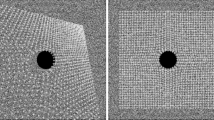Abstract
A detailed evaluation of the feasibility of determining displacements and displacement gradients from measured surface displacement fields is presented. An improved methodology for both the estimation and elimination of noise is proposed. The methodology is used to analyze the gradients for three tests: (1) uniform rotation, (2) uniform strain, and (3) crack-tip displacement fields. Results of the study indicate that the proposed methodology can be used to extract the underlying two-dimensional displacements and their corresponding gradients from the noisy data with reasonable accuracy. Specifically, it is shown that (a) the digital correlation method for acquiring displacement fields has an error in strain of approximately 150 μ strain at each point, (b) the average strain in a region of uniform strain has much less error, typically on the order of 20 μ strain, (c) the displacement ‘nolse’ present in digital correlation is very small, approximately 0.01 pixels, (d) the proposed methodology for reducing noise in the data is essential to the accurate evaluation of displacement gradients and (e) the successful evaluation of displacement and displacement gradients for all three cases indicates that the proposed methodology can be used both to quantify the displacement fields and to reasonably estimate the overall gradient trends.
Similar content being viewed by others
References
Segalman, D.J., Woyak, D.B. andRowlands, R.E., “Smooth Spline-like Finite-element Differentiation of Full-field Experimental Data over Arbitrary Geometry,”Experimental Mechanics,19 (12),429–437 (1979).
Feng, Z. andRowlands, R.E., “Continuous Full-field Representation and Differentiation of Three-Dimensional Experimental Vector Data,”Comp. and Struct.,26 (6),979–990 (1987).
Rowlands, R.E., Winters, K.D. andJensen, J.A., “Full-Field Numerical Differentiation,”J. Strain Analysis,13 (3),177–183 (1978).
Tessler, A., Freese, A., Anastasi, R., Serabian, S., Oplinger, D. and Katz, A., “Least-Squares Penalty-Constraint Finite Element Method for Generating Strain Fields from Moire Fringe Patterns,” Proc. 1987 SPIE Conf. on Photomechanics and Speckle Metrology, 814, 314–323 (1987).
Englestad, M.J., Chambless, D.A., Swinson, W.F. andTurner, J.L., “Hybrid Stress Analysis of Vibrating Plates Using Holographic Interferometry and the Finite-element Method,”Experimental Mechanics,27 (1),23–30 (1987).
Wahba, G., “Smoothing Noisy Data by Spline Functions,”Numersche Mathematik,24,383–393 (1975).
Craven P. andWahba, G., “Smoothing Noisy Data with Spline Functions: Estimating the Correct Degree of Smoothing by the Method of Generalized Cross Validation,”Numerische Mathematik,31,377–405 (1979).
Busby, H.R. andDohrmann C.R., “Algorithms for Smoothing Noisy Data with Spline Functions and Smoothing Parameter Selection,”Proc. VI Int. Cong. on Exp. Mech.,II,843–849 (1988).
Dohrmann, C.R. and Busby, H.R., “Spline Function Smoothing and Differentiation of Noisy Data on a Rectangular Grid,” Proc. 1990 SEM Spring Conf. on Exp. Mech., 76–84 (1990).
Sutton, M.A., Cheng, M., Peters, W.H., III, Chao, Y.J. andMcNeill, S.R., “Application of an Optimized Digital Correlation Method to Planar Deformation Analysis,”Image and Vision Computing,4,143–150 (1986).
Bruck, H.A., McNeill, S.R., Sutton, M.A. andPeters, W.H., III, “Digital Image Correlation Using Newton-Raphson Method of Partial Differential Corrections,”Experimental Mechanics,28 (3),261–267 (1989).
Bruck, H.A., McNeill, S.R., Russell, S.S. and Sutton, M.A., “Use of Digital Image Correlation for the Determination of Displacements and Strains,” Nondestructive Testing of Aerospace Requirements, ed. G.L. Workman, Gordon and Breach, 99–111 (1989).
Sutton, M.A., Turner, J.L., Chae, T.A. and Bruck, H.L., “Development of a Computer Vision Methodology for the Analysis of Surface Deformations in Magnified Images,” ASTM STP 1094: MICON 90, Advances in Video Technology for Microstructural Control (1990).
Sutton, M.A., Turner, J.L., Chae, T.A. and Bruck, H.L., “Experimental Investigations of Three-Dimensional Effects Near a Crack Tip Using Computer Vision,” Int. J. Fract. (1990).
Chambless D.A., Suhling, J.C., Swinson, W.F. and Turner, J.L., “A New Hybrid Photoelastic-Finite Element Technique for Stress Analysis,” Proc. 1986 SEM Spring Conf on Exp. Mech., 991–999 (1986).
Paris, P.C. andSih, G.C., “Stress Analysis of Cracks,”ASTM STP, 391, 30–81 (1965).
Author information
Authors and Affiliations
Rights and permissions
About this article
Cite this article
Sutton, M.A., Turner, J.L., Bruck, H.A. et al. Full-field representation of discretely sampled surface deformation for displacement and strain analysis. Experimental Mechanics 31, 168–177 (1991). https://doi.org/10.1007/BF02327571
Received:
Revised:
Issue Date:
DOI: https://doi.org/10.1007/BF02327571




